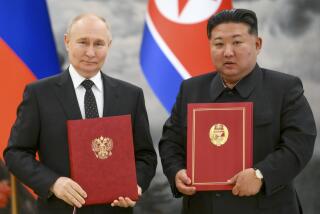North Korea from the inside
- Share via
I’VE TRAVELED to some amazing places. But visiting North Korea, which has been largely closed to the outside world for more than 50 years, presented special challenges, particularly to an American.
North Koreans are taught that the United States instigated the Korean War, and the country’s leaders urge its citizens to be in a constant state of preparedness under the threat of a U.S. nuclear strike. In 2002, President Bush named North Korea a member of an “axis of evil.” North Korean rhetoric has been no less superheated, at various times -- before and after being declared “evil” -- promising to turn the South Korean capital of Seoul, Japan and the United States itself into a “sea of fire.”
Over the years, however, there have been several opportunities for Americans to enter the Democratic People’s Republic of Korea for a limited time. Such a chance most recently coincided with one of the most fascinating of human spectacles, the Arirang Mass Gymnastic Games. I was able to visit North Korea for the first time in 2005 (and return in 2006), flying Air Koryo on a Russian-made Ilyushin 62 from Beijing to Pyongyang.
Any outsider’s time in North Korea is carefully controlled by the state, with visitors kept to minded groups or within well-defined limits (I was warned not to stray more than 100 meters from the hotel in Pyongyang when not on a guided excursion). But the public face North Korea chooses to present to the few visitors allowed in, and the unscripted moments glimpsed, are all the more fascinating for the country’s closed and defensive stance as a “hermit kingdom” (a nickname originating in 19th century Korea’s closed-border policy that attempted to limit foreign encroachment).
The leash was long enough to allow some human interaction with people other than our guides -- photographs of whom were allowed by permission of a smile or a positive shake of the head -- but any verbal communication was of grave concern. Our guides were open within limitations -- no direct political discussion of any sort -- and a genuine fondness grew between us, despite the rhetoric at stops such as the War Museum on the North Korean side of the DMZ. On that visit, I was able to come from the North to within a few feet of where I had stood several years earlier on the south side of the concrete Military Demarcation Line dividing the two Koreas.
More to Read
Sign up for The Wild
We’ll help you find the best places to hike, bike and run, as well as the perfect silent spots for meditation and yoga.
You may occasionally receive promotional content from the Los Angeles Times.






